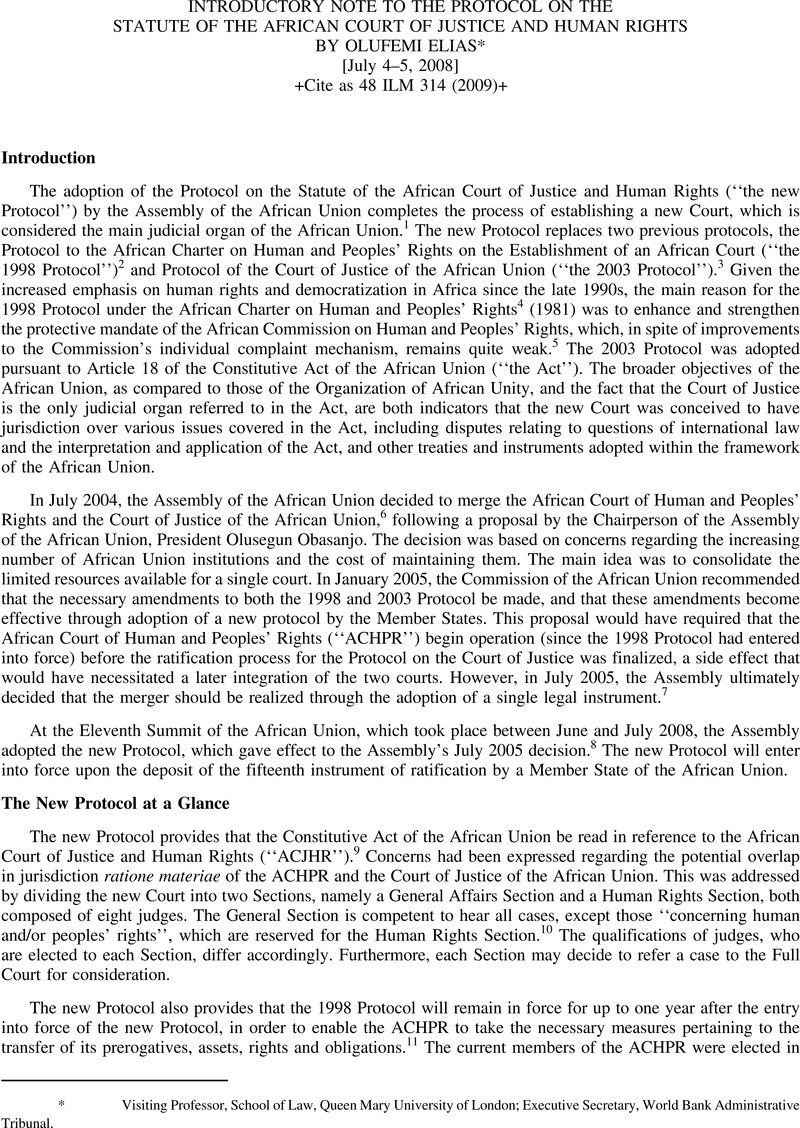No CrossRef data available.
Published online by Cambridge University Press: 27 February 2017

* This text was reproduced and reformatted from the text available at the African Union website: (visited March 10, 2009) <http://www.africa-union.org/root/au/Documents/Treaties/text/Protocol%20on%20the%20Merged%20Court%20-%20EN.pdf>
1 Protocol on the Statute of the African Court of Justice and Human Rights, art. 2, available at http://www.hurisa.org.za/Advocacy/AfricanCourt/Single_Legal_Instument.pdf [hereinafter New Protocol].
2 Protocol to the African Charter on Human and Peoples’ Rights on the Establishment of an African Court, adopted on June 10, 1998, entered into force January 25, 2004, OAU Doc. OAU/LEG/EXP/AFCHPR/PROT(III), available at http://www.oecd.org/dataoecd/42/47/38963691.pdf. The Draft Protocol, which was adopted unmodified, is reprinted in 9 AFR. J. INT’L & COMP. L. 953 (1997).
3 Protocol of the Court of Justice of the African Union, July 11, 2003, reprinted in 13 AFR. J. INT’L & COMP. L. 115 (2005).
4 African Charter on Human and Peoples’ Rights, adopted June 27, 1981, OAU Doc. CAB/LEG/67/3/Rev. 5, reprinted in 21 I.L.M. 58 (1982), entered into force October 21, 1986.
5 The Commission is a quasi-judicial body without the power to make binding decisions. Its functions are limited to examining state reports, considering communications alleging violations, and interpreting the Charter. See, e.g., G. M. Wachira & A. Ayinla, Twenty Years of Elusive Enforcement of the Recommendations of the African Commission on Human and People’s Rights: A Possible Remedy, 6 AFR. HUM. RTS. L.J. 465 (2006).
6 Decisions on the Seats of the African Union, Assembly/AU/Dec. 45 (III), ¶ 4, adopted July 6-8, 2004.
7 Decision on the Merger of the African Court on Human and Peoples’ Rights and the Court of Justice of the African Union, Assembly/AU/Dec. 83 (V), adopted July 4-5, 2005. The decision expressed the Assembly’s gratitude for the offer of the Minister for Foreign Affairs of Algeria and former President of the International Court of Justice, Mohammed Bedjaoui, to contribute to the drafting of the new Protocol.
8 Decision on the Single Legal Instrument on the Merger of the African Court on Human and Peoples’ Rights and the African Court of Justice, Assembly/AU/Dec. 196 (XI) June 30-July 1, 2008
9 New Protocol, supra note 1, art. 3. See N. Udombana, An African Human Rights Court and an African Court: A Needful Duality or A Needless Duplication?, 28 BROOK. J. INT’L L. 811 (2002-2003) (arguing for the merger).
10 Statute of the African Court of Justice and Human Rights, arts. 16 & 17.
11 New Protocol, supra note 1, art 7. Protocol of the Court of Justice of the African Union, art. 60 (provides for its entry into force after ratification by fifteen Member States. The fifteenth instrument of ratification was deposited by Algeria in January 2008).
12 The ACHPR is yet to hear any cases.
13 See, e.g., Ibrahim Ali Badawi El-Sheikh, The Future Relationship between the African Court and the African Commission, 2 AMFR HUM. RTS. L.J. 252 (2002).